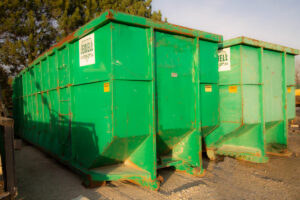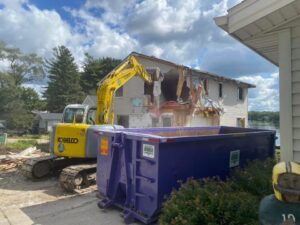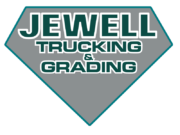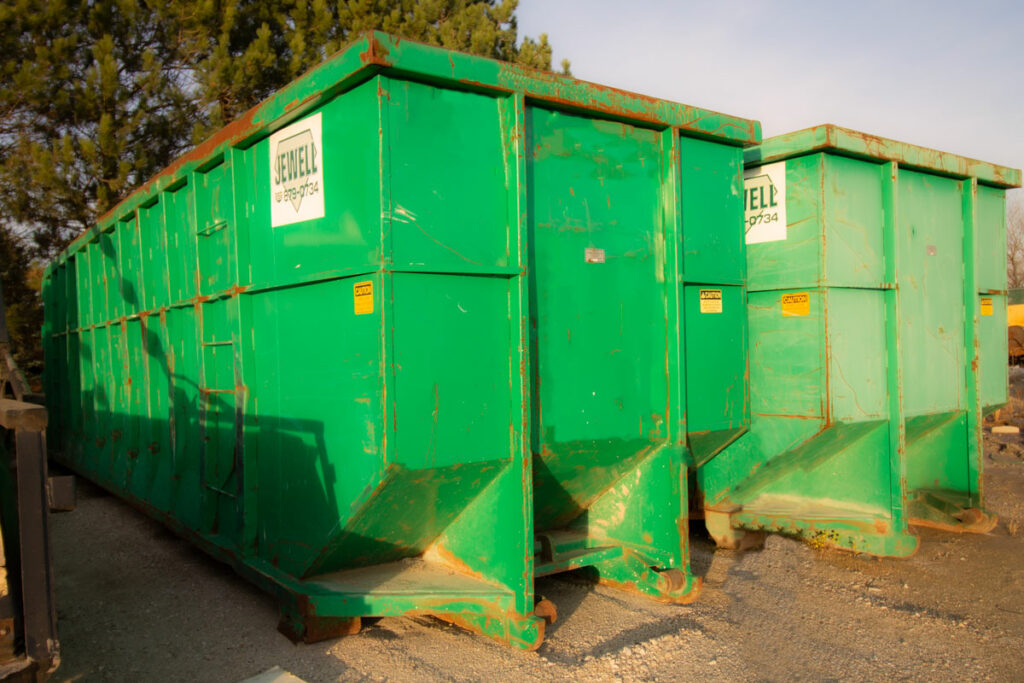Roll-off dumpsters are an essential part of any large cleanup project, whether you’re managing a construction site, a renovation, or a home cleanout. Loading a roll-off dumpster properly is crucial for both safety and efficiency. Mishandling the loading process can lead to accidents, wasted space, or even fines for improper use. At Jewell Trucking, we know how important it is to make sure the job is done safely and correctly.
In this guide, we’ll cover the best practices and safety tips for loading a roll-off dumpster. Whether you’re a homeowner tackling a big project or a contractor managing debris, these insights will help you maximize the space in your dumpster, protect your workers or family, and ensure everything is disposed of properly.
1. Understand Your Dumpster’s Weight and Size Limits
Before you begin loading your roll-off dumpster, it’s essential to understand the weight and size limits of the dumpster you’ve rented. Dumpsters come in a variety of sizes, typically ranging from 10 to 40 cubic yards, and each has a specific weight limit. Exceeding these limits can result in overage fees or difficulty in transporting the dumpster safely.
Here’s how to ensure you stay within the limits:
- Choose the right size for your project: A 10-yard dumpster might be ideal for small residential cleanouts, while a 40-yard dumpster is better suited for large construction debris. Assess the scope of your project and consult with your dumpster provider, like Jewell Trucking, to select the best size.
- Consider the weight of your materials: Different materials weigh different amounts. Concrete, dirt, and roofing shingles are heavier than household items like furniture or cardboard. Be mindful of the types of materials you’re loading, and ask your dumpster provider about weight restrictions.
- Even distribution: Always distribute heavy items evenly throughout the dumpster. This helps prevent tipping when the dumpster is picked up and ensures safe transport.

2. Sort Your Materials Before You Load
Sorting your materials before you load the dumpster can save time and reduce the risk of accidents. Additionally, many landfills have strict rules about what can and cannot be disposed of in a roll-off dumpster. Sorting helps you stay compliant with local regulations.
What should you sort?
- Hazardous materials: Items like paints, solvents, chemicals, and batteries are often considered hazardous and cannot be thrown into a standard roll-off dumpster. Make sure you identify these items and dispose of them separately according to local guidelines.
- Reusable or recyclable materials: If you have materials that can be recycled or reused, such as metal, wood, or electronics, set these items aside for recycling. Recycling can save space in the dumpster and is better for the environment.
- Bulky items: Large, bulky items, such as furniture, appliances, or large pieces of wood, should be strategically loaded to maximize space and maintain balance in the dumpster.
Sorting your materials also allows you to load the dumpster more efficiently, which brings us to our next tip.
3. Load Heavy Items First
When loading a roll-off dumpster, it’s always best to start with the heaviest items. This provides a stable base and ensures the dumpster remains balanced when it is lifted and transported. Heavy materials, such as concrete, bricks, or metal, should be placed at the bottom and spread evenly across the dumpster’s surface.
Best practices for loading heavy items:
- Avoid stacking too high: Large or heavy items should not be stacked high in the dumpster as they can become unstable and fall, potentially causing injury or damage.
- Use proper lifting techniques: When lifting heavy items, bend your knees, keep your back straight, and lift with your legs, not your back. Overexerting yourself can lead to injury, so always use proper lifting techniques or seek assistance when needed.
Once the heavy items are securely in place, you can start adding lighter materials.
4. Break Down Bulky Items
Maximizing the space in your roll-off dumpster is key to getting the most out of your rental. One of the best ways to conserve space is by breaking down bulky items before placing them in the dumpster. This allows you to pack more debris and reduce air gaps between materials.
Items you can break down include:
- Furniture: Disassemble large pieces of furniture, such as sofas, tables, and bookshelves. Removing legs and arms from furniture can help you fit more into the dumpster.
- Boxes and packaging materials: Flatten cardboard boxes and other packaging materials before loading them into the dumpster.
- Construction debris: Cut or break down long pieces of wood, drywall, or metal to make them easier to stack.
Breaking down bulky items not only helps maximize space but also makes it safer to load the dumpster by reducing the chance of items shifting during transport.
5. Stack Items Strategically
Strategic stacking is another way to maximize the space in your roll-off dumpster. After loading the heavy items and breaking down bulky materials, start stacking lighter items in a way that ensures even distribution and maximizes the available space.
Tips for stacking items efficiently:
- Place flat items first: Items like wood planks, flat metal, and cardboard should be placed first to create an even surface.
- Fill gaps: Use smaller or oddly-shaped items to fill in gaps between larger objects. This not only helps you fit more into the dumpster but also prevents items from shifting during transport.
- Distribute weight evenly: Ensure that the weight is evenly distributed across the dumpster to prevent tipping or unsafe transport.
By carefully stacking your materials, you can get the most out of your roll-off dumpster while ensuring safe and efficient transport.
6. Avoid Overfilling the Dumpster
One of the most common mistakes people make when loading a roll-off dumpster is overfilling it. Overfilled dumpsters can pose several risks, including falling debris during transport, difficulty lifting the dumpster, and even fines for exceeding capacity.
How to avoid overfilling:
- Follow the fill line: Most dumpsters have a fill line indicating the maximum safe level for loading. Never stack debris above this line, as doing so can create an unsafe situation for both you and the driver.
- Compact materials: If you’re running out of space but haven’t reached the fill line, try compacting materials by breaking them down further or shifting items to fill gaps.
- Rent a larger dumpster if needed: If you find that your project generates more debris than expected, consider renting a larger dumpster. Overfilling a smaller dumpster can lead to additional fees, so it’s often more cost-effective to upgrade to a larger size.
7. Ensure Safe Access to the Dumpster
It’s essential to keep the area around the roll-off dumpster clear and accessible throughout your project. This ensures that workers or family members can safely load debris without tripping hazards or other obstacles.
Best practices for maintaining safe access:
- Clear the loading area: Keep the area around the dumpster free of debris, tools, and other materials that could cause trips or falls.
- Use the dumpster door: Many roll-off dumpsters have a door that opens, allowing easier access to load heavy or bulky items. Use this door to safely load large materials instead of lifting them over the side of the dumpster.
- Avoid working in bad weather: Loading a dumpster in the rain or on wet ground can increase the risk of slips and falls. Wait for dry, stable conditions whenever possible.
Maintaining safe access to the dumpster not only protects those loading it but also helps ensure that the dumpster can be safely picked up and transported by the rental company.

![]()
![]()
8. Follow Local Disposal Regulations
Each municipality has its own rules and regulations regarding the types of materials that can be disposed of in a roll-off dumpster. Failing to follow these regulations can result in fines or penalties, and certain items may even pose environmental or safety hazards.
Materials typically prohibited in dumpsters:
- Hazardous waste: As mentioned earlier, items such as paints, solvents, and chemicals are often prohibited in roll-off dumpsters.
- Tires: Many landfills do not accept tires due to environmental concerns.
- Appliances with Freon: Appliances like refrigerators or air conditioners that contain Freon must be disposed of according to specific guidelines.
- Batteries and electronics: Some electronic devices and batteries contain hazardous materials and must be recycled through special programs.
Before loading your dumpster, check with Jewell Trucking or your local waste management facility to ensure compliance with all disposal regulations.
Trust the Experts at Jewell Trucking for Roll-Off Dumpsters
Loading a roll-off dumpster safely and efficiently requires planning, proper techniques, and an understanding of weight and size limits. By following the tips and best practices outlined above, you can ensure that your dumpster is loaded in a way that maximizes space, protects your workers or family members, and complies with local regulations.
At Jewell Trucking, we specialize in roll-off dumpster rentals and are committed to helping our customers get the job done right. Whether you’re working on a home renovation, a commercial construction project, or a large cleanout, our team is here to provide expert advice and support.
If you need assistance selecting the right dumpster size for your project or have any questions about proper loading techniques, then don’t hesitate to reach out to us. Let Jewell Trucking help you keep your project safe, efficient, and compliant.



